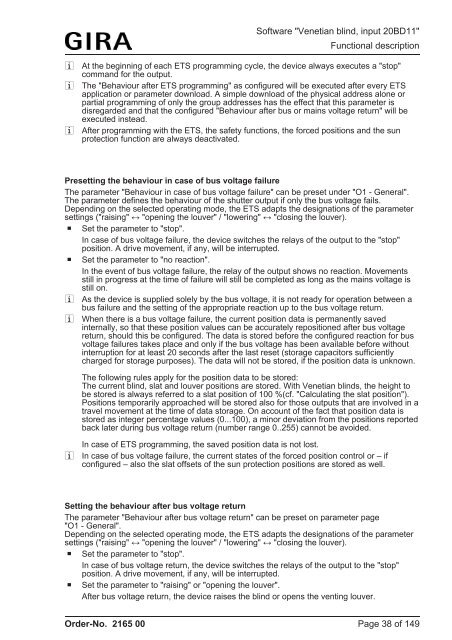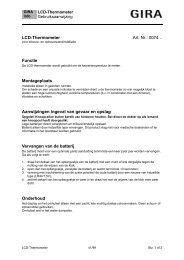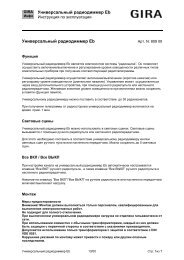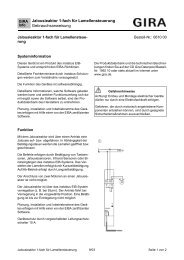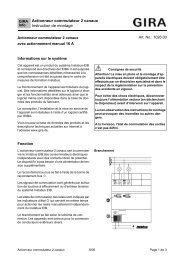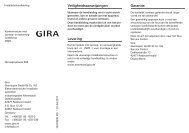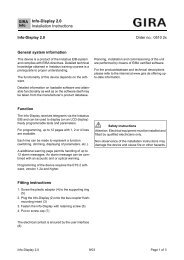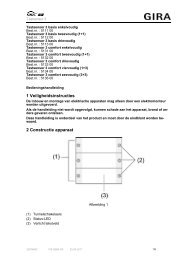Blind actuator 1-gang flush-mounted Order-No. 2165 00 - Gira
Blind actuator 1-gang flush-mounted Order-No. 2165 00 - Gira
Blind actuator 1-gang flush-mounted Order-No. 2165 00 - Gira
You also want an ePaper? Increase the reach of your titles
YUMPU automatically turns print PDFs into web optimized ePapers that Google loves.
Software "Venetian blind, input 20BD11"<br />
Functional description<br />
i At the beginning of each ETS programming cycle, the device always executes a "stop"<br />
command for the output.<br />
i The "Behaviour after ETS programming" as configured will be executed after every ETS<br />
application or parameter download. A simple download of the physical address alone or<br />
partial programming of only the group addresses has the effect that this parameter is<br />
disregarded and that the configured "Behaviour after bus or mains voltage return" will be<br />
executed instead.<br />
i After programming with the ETS, the safety functions, the forced positions and the sun<br />
protection function are always deactivated.<br />
Presetting the behaviour in case of bus voltage failure<br />
The parameter "Behaviour in case of bus voltage failure" can be preset under "O1 - General".<br />
The parameter defines the behaviour of the shutter output if only the bus voltage fails.<br />
Depending on the selected operating mode, the ETS adapts the designations of the parameter<br />
settings ("raising" ↔ "opening the louver" / "lowering" ↔ "closing the louver).<br />
o Set the parameter to "stop".<br />
In case of bus voltage failure, the device switches the relays of the output to the "stop"<br />
position. A drive movement, if any, will be interrupted.<br />
o Set the parameter to "no reaction".<br />
In the event of bus voltage failure, the relay of the output shows no reaction. Movements<br />
still in progress at the time of failure will still be completed as long as the mains voltage is<br />
still on.<br />
i As the device is supplied solely by the bus voltage, it is not ready for operation between a<br />
bus failure and the setting of the appropriate reaction up to the bus voltage return.<br />
i When there is a bus voltage failure, the current position data is permanently saved<br />
internally, so that these position values can be accurately repositioned after bus voltage<br />
return, should this be configured. The data is stored before the configured reaction for bus<br />
voltage failures takes place and only if the bus voltage has been available before without<br />
interruption for at least 20 seconds after the last reset (storage capacitors sufficiently<br />
charged for storage purposes). The data will not be stored, if the position data is unknown.<br />
The following rules apply for the position data to be stored:<br />
The current blind, slat and louver positions are stored. With Venetian blinds, the height to<br />
be stored is always referred to a slat position of 1<strong>00</strong> %(cf. "Calculating the slat position").<br />
Positions temporarily approached will be stored also for those outputs that are involved in a<br />
travel movement at the time of data storage. On account of the fact that position data is<br />
stored as integer percentage values (0...1<strong>00</strong>), a minor deviation from the positions reported<br />
back later during bus voltage return (number range 0..255) cannot be avoided.<br />
In case of ETS programming, the saved position data is not lost.<br />
i In case of bus voltage failure, the current states of the forced position control or – if<br />
configured – also the slat offsets of the sun protection positions are stored as well.<br />
Setting the behaviour after bus voltage return<br />
The parameter "Behaviour after bus voltage return" can be preset on parameter page<br />
"O1 - General".<br />
Depending on the selected operating mode, the ETS adapts the designations of the parameter<br />
settings ("raising" ↔ "opening the louver" / "lowering" ↔ "closing the louver).<br />
o Set the parameter to "stop".<br />
In case of bus voltage return, the device switches the relays of the output to the "stop"<br />
position. A drive movement, if any, will be interrupted.<br />
o Set the parameter to "raising" or "opening the louver".<br />
After bus voltage return, the device raises the blind or opens the venting louver.<br />
<strong>Order</strong>-<strong>No</strong>. <strong>2165</strong> <strong>00</strong><br />
Page 38 of 149


